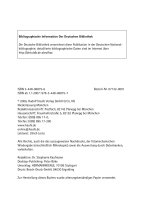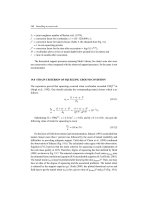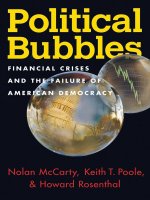barton et al - dangerous markets; managing in financial crises (2003)
Bạn đang xem bản rút gọn của tài liệu. Xem và tải ngay bản đầy đủ của tài liệu tại đây (2.53 MB, 321 trang )
Praise for Dangerous Markets
“Financial crises are hardly limited to the purview of central bankers
and regulators. The authors skillfully demonstrate that financial crises
offer both peril and promise. A ‘must read’ for top management of any
global company, whether a financial or a nonfinancial institution.”
Ronald P. O’Hanley
Vice Chairman, Mellon Financial Corp.
“Based on their vast experience in financial crises around the world
during recent years, the authors have developed an impressive review
of the origins of and solutions to financial crises. The cost of such
crises can be minimized and the path to recovery established earlier if
bankers, other corporate executives, and public finance officials take
advantage of this effort and apply the lessons learned from their signif-
icant work.”
Charles H. Dallara
Managing Director, Institute of International Finance, Inc.
“Dangerous Markets is a ‘must read’ in the current global environ-
ment for all serious investors and senior executives. The McKinsey
authors bring a unique practitioners’ perspective to the challenges of
anticipating, managing, and succeeding in financial crises, and close
with an intriguing call for leading private sector players to step up
their role in promoting new market standards and structures to help
avoid future financial crises and minimize their potential impact.”
Robert R. Glauber
Chairman and CEO,
National Association of Securities Dealers, Inc.
former Under Secretary of the U.S. Treasury Department
former Harvard Business School professor
“The authors address an issue of enormous importance in today’s
volatile world. They emphasize the critical role that the management
of financial institutions can play, not only in leading their own institu-
tions through choppy waters, but in helping shape the development of
more robust financial systems.”
Peter Sands
Group Finance Director, Standard Chartered Bank
“Barton, Newell, and Wilson provide new and important insights into
financial crises based on their extensive and successful work with pri-
vate financial institutions and with governments. They offer clear and
persuasive guidance on how best to avoid crises, how to see them com-
ing, and what to do when they happen. This is best-practice counsel
from three leaders in the field. They have worked in the trenches, and
bring a vital private sector perspective.”
Martin N. Baily
Senior Fellow, Institute for International Economics
former Chairman of the Council of Economic Advisers
“The book results from a fresh and imaginative approach to financial
crises in the past few years, particularly from a corporation’s stand-
point. The insights are precious to top executives as well as to regula-
tors and academics; in fact, the book provides a very skillful
demonstration of the value of the dialogue between all interested par-
ties on the issue of financial crises. Since the focus of such crises is now
moving toward nonfinancial corporations, the book becomes even
more timely and important.”
Gustavo Franco
Partner, Rio Bravo Investimentos
Professor of Economics, Pontífica Universidade Católica
former Governor of the Central Bank of Brazil
“As a member of the private equity investment community, I recom-
mend Dangerous Markets to all members of the world business com-
munity. Their insights provide valuable lessons which if applied can
make the world markets much more efficient and stable.”
Steven Lee
Partner, Lone Star Fund
“Based on their unparalleled experience consulting during financial
crises, Barton, Newell, and Wilson offer a fresh perspective on such
episodes. The microeconomic focus—as opposed to the conventional
macro view—provides important new insights into the difficult art of
forecasting and surviving these storms.”
Dr. José A. Scheinkman
Chaire Blaise Pascal de l’État et de la Region Île de France
Theodore Wells ’29 Professor of Economics,
Princeton University
DANGEROUS MARKETS
Managing in Financial Crises
DOMINIC BARTON
ROBERTO NEWELL
GREGORY WILSON
John Wiley & Sons, Inc.
New York • Chichester • Weinheim • Brisbane • Singapore • Toronto
Copyright © 2003 by Dominic Barton, Roberto Newell, and Gregory Wilson. All rights
reserved.
Published by John Wiley & Sons, Inc., Hoboken, New Jersey
Published simultaneously in Canada
No part of this publication may be reproduced, stored in a retrieval system, or transmitted
in any form or by any means, electronic, mechanical, photocopying, recording, scanning
or otherwise, except as permitted under Section 107 or 108 of the 1976 United States
Copyright Act, without either the prior written permission of the Publisher, or authoriza-
tion through payment of the appropriate per-copy fee to the Copyright Clearance Center,
222 Rosewood Drive, Danvers, MA 01923, 978-750-8400, fax 978-750-4470, or on the
web at www.copyright.com. Requests to the Publisher for permission should be addressed
to the Permissions Department, John Wiley & Sons, Inc., 111 River Street, Hoboken, NJ
07030, 201-748-6011, fax 201-748-6008, email:
Limit of Liability/Disclaimer of Warranty: While the publisher and author have used their
best efforts in preparing this book, they make no representations or warranties with
respect to the accuracy or completeness of the contents of this book and specifically dis-
claim any implied warranties of merchantability or fitness for a particular purpose. No
warranty may be created or extended by sales representatives or written sales materials.
The advice and strategies contained herein may not be suitable for your situation. You
should consult with a professional where appropriate. Neither the publisher nor author
shall be liable for any loss of profit or any other commercial damages, including but not
limited to special, incidental, consequential, or other damages.
For general information on our other products and services, or technical support, please
contact our Customer Care Department within the United States at 800-762-2974, out-
side the United States at 317-572-3993, or fax 317-572-4002.
This title is also available in print as ISBN 0-471-22686-6. Some content that appears in
the print version of this book may not be available in this electronic edition.
For more information about Wiley products, visit our web site at www.Wiley.com
To my wife, Sheila, and my children, Fraser and Jessica
Dominic
To my wife, Tamara, and my children, Laurence, DeNeen, and Tatiana
Roberto
To my wife, Beejay, my children, Sarah and Christopher, and in memory
of my parents, Paul and Lorayne S. Wilson
Gregory
contents
Preface xi
Why Manage Financial Crises Proactively? xi
Why We Wrote Dangerous Markets xv
Acknowledgments xix
CHAPTER 1
Introduction to Dangerous Markets 1
Financial Storms Are Destabilizing 2
Financial Crises Can Be Understood, Anticipated, Managed,
and Prevented 3
What This Book Is and Is Not 4
Who Needs to Read Dangerous Markets?4
Part I: Understanding Financial Crises 7
Part II: Earning the Right to Win 9
Part III: Managing Unique Banking Risks 12
Part IV: Building for the Future 13
PART I
Understanding Financial Crises 17
CHAPTER 2
Recognizing New Global Market Realities 19
Increasing Risk of Financial Crises 22
Why Financial Crises Are on the Rise 27
You Can Run, But You Can’t Hide From Crises 36
Looking Ahead 39
CHAPTER 3
Using Crisis Dynamics to See Growing Risks 40
The Chronology of a Crisis 42
The Dynamics of a Financial Crisis 47
vii
The Corporate Sector: Assessing Value Destruction 48
The Financial Sector: Banks in Distress 52
Understanding the Impact of Macroeconomic Catalysts,
Foreign Funding, and Asset Bubbles 63
Conclusions and Outlook for Future Crises 71
Appendix 3.1: Ten Warning Signs of a Financial Crisis 79
Appendix 3.2: Estimating Value Destruction in the Economy 82
Appendix 3.3: Why Corporate Sectors Underperform in Crisis
Economies 84
PART II
Earning the Right to Win 87
CHAPTER 4
Managing the First Hundred Days 89
Taking Five Tactical Steps When a Crisis Hits 90
Developing a Crisis Management Approach 109
Managing the CEO Agenda 112
Appendix 4.1: Painting the Picture of a Financial Crisis 118
Appendix 4.2: How Companies Can Strengthen Funding
Before a Crisis 124
Appendix 4.3: Using Scenario Planning in Financial Crises 127
CHAPTER 5
Capturing Strategic Opportunities After the Storm 132
Recognizing Significant Opportunities in a Crisis 134
Moving from Boundaries to Greater Degrees of Freedom 136
Executing Successfully to Capture Crisis Opportunities 146
Appendix 5.1: Leveraging Strategic Opportunities in
Financial Crises: The Successful Story of NCNB 154
PART III
Managing Unique Banking Risks 159
CHAPTER 6
Driving Successful Bank Turnarounds 161
Ensuring Turnaround Success: Seven Management Actions 162
Mellon Bank’s Successful Turnaround 169
viii contents
Christiana Bank’s Successful Turnaround 175
Filanbanco’s Failed Turnaround 177
Government Stewardship of Troubled Banks 180
Government’s Role in Bank Turnaround Strategies 188
Appendix 6.1: Building a Rationale for Official Support
in a Financial Crisis 192
CHAPTER 7
Minimizing Costs Through NPL Recovery Excellence 196
Developing World-Class NPL Recovery Capabilities 198
Special Issues Raised When NPLs Are Managed by Governments 216
Management Lessons: Good Banks/Bad Banks in Scandinavia 222
PART IV
Building for the Future 227
CHAPTER 8
Strengthening System Safeguards 229
Moving to Global Standards for Corporate Governance 234
Adopting Better Accounting Standards 236
Developing Capital Markets 241
Resetting Regulatory Regimes 246
Building an Effective Legal Foundation 251
Appendix 8.1: Sixteen Elements of Good Corporate Governance 255
Appendix 8.2: Singapore’s Development as an International
Financial Center 257
Appendix 8.3: The Discipline of the Market for Corporate
Control: Issues for CEOs 259
CHAPTER 9
Designing a New, Market-Driven Financial Architecture 261
Recognizing the Limitations of Current Standards
and Approaches 262
Enhancing the Private Sector’s Role in Setting Standards
to Reduce the Risk of Future Crises 264
Appendix 9.1: FSF Compendium of Standards 276
Endnotes 277
Glossary 293
Index 295
contents ix
preface
WHY MANAGE FINANCIAL CRISES PROACTIVELY?
Financial crises are simply too important and too costly to shareholders and
societies to leave unmanaged. There is no question that there are real dan-
gers in financial crises: Companies go bankrupt, management teams are
fired, investors lose their money, employees lose their jobs, pensions disap-
pear, deposits are frozen in time, personal savings get depleted, civil unrest
increases, public riots can break out, contagion spreads across political bor-
ders, secondary effects appear such as higher risk premiums in other unsus-
pecting countries, and, finally, governments fall—as they did in Indonesia,
Ecuador, Russia, and Argentina in recent years.
Too often, we see companies and entire sectors of an economy that are
consistently destroying shareholder value year after year, sowing the seeds of a
future crisis. Too often, we find fundamentally weak banking systems, espe-
cially in emerging markets where the banks play a disproportionate role in the
national economy compared to less volatile capital markets. Too often, these
weak national systems are linked inefficiently to global capital markets,
increasing the cost of capital locally to all borrowers—individual consumers,
businesses, and governments alike. Too often, we see weak corporate gover-
nance or inadequate accounting and transparency. Invariably, we find weak
financial regulators who lack both the needed skills and political indepen-
dence to do their jobs adequately. Too often, weak national systems are hooked
up to the global capital markets before they are ready, and a lot of money
flows in under misguided assumptions, increasing the potential for crisis.
Consequently, financial crises are occurring more frequently, with costs
that are measured by as much as one-quarter or one-half of a nation’s GDP.
They also have long time horizons, measured in years, not months. At dif-
ferent levels, contagion is now a fact of life in the world. Moreover, there is
no end in sight. We believe firmly in the net benefits of dynamic market
forces and globalization, but the collision of these forces with weak economies
and weak financial systems exposes the rot lying below the surface in many
countries and, in our view, will only increase the rate and intensity of crises
in the future.
That’s why financial crises need to be managed.
xi
Yet, too many companies and too many countries fail to manage their
crises proactively: Unfortunately for shareholders and taxpayers, they react
day-to-day and usually lack a viable plan to navigate their way out of the
financial storm that has engulfed them. Crises are often seen as random, cat-
astrophic events, yet every client with whom we have worked regrets not
having been prepared adequately. Crises are not going away.
From our global perspective, we see at least two major benefits to man-
aging a crisis proactively. First, there are real financial savings by minimizing
the crisis resolution costs imposed on these same shareholders and taxpayers.
Second, there are real competitive benefits as well, if executives can act
swiftly before or after a crisis hits to seize new opportunities and secure a
winning position as economic growth returns in the post-crisis world. Conse-
quently, both companies and nations have a huge economic self-interest in
getting crisis management right. While some elements seem out of control,
many are manageable with the proper planning and resources.
Managers in the midst of a financial crisis have an undeniable self-
interest in survival and protecting their shareholders. Since financial crises
can rob a country of years of needed economic development, policymakers
have an equal self-interest in preserving GDP growth on behalf of the
societies they represent. With the right combination of vision, leadership,
strategy, courage, and operational and financial capabilities, however, exec-
utives can manage crises to optimize their competitive or national self-
interest: Crisis resolution costs can be minimized; crisis durations can be
shortened; corporate and national solvency can be restored more quickly;
competitive positions can be enhanced; financial systems can be saved and
reset for the global world in which we live; and economic growth can be
restored and sustained. However, it takes commitment, skills, toughness,
and hard work.
Just as executives have a clear self-interest in actively managing finan-
cial crises, they also have options that they can exercise.
For a moment, imagine two huge power stations supplying electricity to
a neighborhood. Suppose you live in a house that receives power from one
of these stations. If your house has up-to-date wiring, with the proper sys-
tem of circuit breakers and controls, you can use all your appliances at the
same time to cook your food, heat your home, and run your computer with
little fear of electrical harm. Perhaps a light bulb will go out, or one circuit
breaker will blow, but overall the house will not have major electrical prob-
lems and the risk of a major mishap is low.
If, however, the house’s wiring is faulty or out-of-date with modern
building codes, then you risk melting your entire electrical system, and per-
haps even setting your house on fire. Of course, you can choose not to oper-
ate on the power grid, as have North Korea and Cuba, for example. In that
xii preface
case, however, you will not be able to obtain the electrical power you need
to run your home.
In addition, your situation may be complicated by the fact that you can
be affected directly by your neighbors if their wiring system isn’t up to the
proper code. If they overload the system or have faulty wiring, the entire neigh-
borhood could be set on fire. Each house needs to have its wiring inspected
regularly to manage power flows and surges, and the power stations in turn
need to manage their systems effectively to ensure that they are delivering
power safely and efficiently.
So it is with the modern global financial system. In this analogy, the
power stations are predominantly the financial hubs in the United States and
the United Kingdom, although national financial systems act as their own
generators and substations that link end users to the ultimate providers. The
electricity is the huge flows of capital and liquidity now available to individ-
uals, companies, and governments from those financial centers. The houses
with modern wiring that are up to current code are those companies, investor
groups, pension funds, and nations equipped with strong economic and
financial fundamentals to withstand sudden power surges or outages. Those
houses with poor wiring operating under outdated codes are those compa-
nies and nations at risk during these times.
Globalization and market forces can either reduce or expand possible
options, but executives still have options that they can exercise to influence
the direction, depth, and pace of crisis resolution in their companies and
reforms within their markets. They do not, however, have options that can
stop financial evolution without negatively affecting their company’s eco-
nomic well-being. This is especially true in countries experiencing a financial
crisis. In fact, the challenges in crisis countries may be more complex, and
their solution space even more severely limited.
In our judgment, therefore, executives have at least three basic options
to consider as they manage a crisis.
1. Default to the pre-crisis status quo. First, executives can default to the
pre-crisis status quo. Some companies and countries do, but this step usu-
ally means reverting to the old ways of doing business and a mostly closed
financial operating system that results in a high-cost, crisis-perpetuating,
low economic growth model.
2. Muddle through. Second, executives can simply muddle through a
financial crisis with reluctant strategy, operational, and policy adjust-
ments. They typically commit only to marginal change, tinkering with
broken ways of conducting business, smoothing over the underlying
core issues, making some concessions to liberalizing markets and the
emergence of the global operating system architecture. If they are lucky,
preface xiii
they may buy time. Yet they will most likely face unresolved issues that
will come back to haunt them.
3. Capture new strategic opportunities. Finally, CEOs and other senior
managers can opt to fundamentally challenge old assumptions and
rebuild their companies and economies. While there are dangers and
there are threats, fresh opportunities are also created as new market
realities set in over time. This third option can maximize a company’s
economic effectiveness by linking directly with the world’s most effi-
cient financial operating systems and securing access to capital at the
lowest possible cost. In turn, sustained real economic growth should be
the long-term reward.
From our perspective, the executives who want to win and secure a sus-
tainable position in the post-crisis endgame owe it to themselves, their
shareholders, and other constituencies to choose option 3, just as policy-
makers owe it to taxpayers to choose option 3 in the name of restarting eco-
nomic growth as soon as possible and safeguarding the financial system from
further crisis. The costs of options 1 and 2 are simply too high to accept.
Regardless of the preferred option, neither CEOs nor policymakers can
avoid responding immediately to crisis and longer-term market forces. Dan-
gerous Markets is designed to assist all senior executives to manage in a
national financial crisis while preparing to compete in a global marketplace.
While policymakers often are forced to take the public lead when a crisis
hits, the private sector—particularly those companies and institutions that
see themselves as part of the backbone of the new economic system that
emerges from the crisis—has an equally important stake in managing finan-
cial crises sooner rather than later.
Initially, both companies and countries are paralyzed, then CEOs and
policymakers are overwhelmed with too much to accomplish, and typically
there is no road map to help them manage a crisis and rebuild. Frankly, we
found ourselves scrambling initially to pull together lessons learned from
other crises and our own client work in other crisis countries, and wonder-
ing if we had all the right insights for clients and if we had the right coun-
tries to compare.
Dangerous Markets is our recommendation for that road map. It is
written for all managers—CEOs, executive operating managers, investors
of all kinds, public officials, and anyone else who has a self-interest in antic-
ipating, weathering, and prospering in a financial crisis. There are certain
general principles and action steps that we always recommend in the early
days of a crisis, such as being better prepared, understanding and managing
your cash position, minimizing your operational risk, conducting scenario
planning, preparing to divest unproductive assets, and maintaining the con-
fidence of key stakeholders. Next, corporations need to be prepared to rein-
xiv preface
vent themselves and to attain a new vision building on five strategic discon-
tinuities: changes in regulatory regimes; competitor strengths; customer
needs; organizational capacity for change; and changing social values. Finally,
among other things, executives need to build specific skills and drive corpo-
rate governance practices to world-class standards. This road map, how-
ever, must be tailored to meet each unique set of national challenges and
opportunities. We know that there is no single magic solution for each and
every company or country.
WHY WE WROTE DANGEROUS MARKETS
This crisis management guidebook, Dangerous Markets, is written from a
microeconomic and practitioner’s perspective. It is drawn from McKinsey
& Company’s extensive client work globally and our significant Firm-
funded research into the causes and impact of financial crises. It is not an
academic treatise, nor does it necessarily address all crisis-related topics for
all occasions.
Rather, we have drawn upon our practical crisis management work for
the private and public sectors in numerous countries. Our journey together
began with Dominic and Greg leading McKinsey’s team that served the
Canadian Task Force on the Future of the Canadian Financial System in
1996 and 1997. Greg then helped a McKinsey team serving the Thai gov-
ernment sort through the wreckage of that country’s finance companies.
Dominic happened to move to Korea on the eve of the Asian financial crisis,
and he, Jungkiu Choi, and Greg led our work for the crisis-born Financial
Supervisory Commission. Dominic also became heavily involved in several
business turnaround situations as well as engagements helping stronger
companies that were determined to use the crisis as an opportunity to
leapfrog their competitors.
Later, they joined other McKinsey colleagues in Singapore, where
McKinsey served the Monetary Authority of Singapore (MAS) and the
Financial Sector Review Group, working beside private sector participants
in the quest to turn Singapore into an Asian financial center. In Indonesia
they were joined by Roberto, who helped other McKinsey colleagues serve
the Indonesian Bank Restructuring Agency (IBRA) reset its strategy and
organizational structure after the first two unproductive years of its exis-
tence. There, too, our practice was involved in serving several major Indone-
sian companies during the crisis.
Financial crises were unfortunately not confined to Asia. In 1998 Greg
got a call from Roberto to join him in Jamaica where multiple McKinsey
teams were assisting the Ministry of Finance and the Financial Institutions
Asset Corporation (FINSAC), Jamaica’s bank restructuring agency and
asset management corporation, to implement solutions that Roberto and
preface xv
others had applied first in the United States, as part of the S&L crisis, and
later in Mexico. Just as the crisis was breaking in Ecuador, Roberto and
Greg traveled there to a series of meetings with the former president, Jamil
Mahuad, to assist Ecuador’s new Agencia de Garantía de Depósitos (AGD).
They also later helped other colleagues in Colombia serve the Fondo de
Garantías de Instituciones Financieras (Fogafín), the Colombian bank
restructuring agency, by conducting a diagnostic and bank recapitalization
program before a real crisis hit there. We have also served private and public
sector clients, individually and collectively, in numerous other countries.
Our roles and the timing of our involvement have varied widely. In
some financial crises, we had limited involvement in the early stages at
the policy level, but we were always actively involved with our private sec-
tor clients. This was the case with Ecuador and Colombia, for example. In
both of these situations, we assisted with the initial diagnostic work that
allowed us to observe firsthand the responses that these two countries sub-
sequently crafted. Despite our best efforts, Ecuador’s embedded problems
eventually turned into a systemic financial sector crisis, and thereafter we
were involved with helping to pick up the pieces with the failed banking
system. In Colombia, we were pleased to see that the government acted
to prevent serious damage to the banking system, and while there were still
significant costs to be paid, the government’s preemptive action prevented a
systemic crisis.
In most cases where we have played an advisory role, our involvement
came later, but still early enough that the key assignments focused on mini-
mizing the potential costs. This was the case in Korea, Jamaica, Colombia,
Indonesia, Thailand, and Mexico, where we became involved after these
countries already had suffered crises engulfing a significant proportion of
the banking system and assets in the real economy.
In some cases, we helped countries create new financial sector visions
after intense iterative processes involving all stakeholders. We also have assisted
governments in devising performance contracts and investment guidelines
that have been used when selecting specific institutions (alternatively called
“backbone” banks or “anchor” banks) that were targeted to be part of the
new financial system. In addition, we have crafted turnaround strategies for
failing banks in Asia, South America, Europe, and the United States.
Moreover, we have spent considerable energy helping create new insti-
tutional capabilities to minimize the cost of financial crisis failures, both
in the private and the public sector. Specifically, these capability-building
engagements included: preparing turnaround programs for troubled banks;
developing “bad banks” and/or capabilities to manage nonperforming loan
portfolios; defining strategies to manage and dispose of other nonbanking
assets; and preparing privatization programs to dispose of both bank and
nonbank corporations.
xvi preface
Finally, we have done extensive work helping countries develop strate-
gies and recommendations not only to stabilize their financial economy, but
also to reset new financial systems that become linked efficiently with the
larger global marketplace and therefore are better equipped to sustain stable
economic growth. In these cases our roles generally have been centered
around: creating new supervisory capabilities to oversee the performance of
banks and other financial intermediaries; preparing policy recommenda-
tions for regulatory and legal change; helping to strengthen corporate gover-
nance structures; and developing capital markets to lower the overall cost of
capital and improve financial market efficiency. We have drawn most of the
lessons described in subsequent chapters from this real-world experience.
In contrast to the many academic studies or official reports from inter-
national financial institutions, our goal has been to use McKinsey’s top
management approach and frontline experience to offer some unique per-
spectives, case examples, and practical solutions, and an actionable, strate-
gic blueprint that our clients can tailor to meet their specific needs. When we
were first drawn into this important work—down in the trenches beside cri-
sis management leaders—we found that few were fully prepared, including
us. There were no textbooks to pick up and read.
We learned by doing—in at least twelve countries, many with similar
problems, all different. We have been teargassed and forced in some cases to
travel with armed guards. We have worked through bank holidays, been
swept up in street demonstrations and riots, and forced at times to evacuate
our client’s work site. At still other times, we were the target of labor agita-
tion and abuse due to our role in bank or company restructuring. Every day
of a crisis has been a new adventure for us, some more exciting than others.
We also found several heroes who inspired us and encouraged us as we
took this journey. In Korea, Hun Jae Lee, the first chairman of the new
Financial Supervisory Commission, was the right man at the right time to
guide Korea’s early crisis response. Y.O. and Y. S. Park, the brothers running
the Doosan Group, and Jung-Tae Kim, the CEO of Kookmin Bank, were
also inspirations to us. In Singapore, Deputy Prime Minister Lee Hsieng
Long, the head of the MAS, had the vision to seize the opportunities that the
surrounding crisis in Asia offered to the city-state to become a leading finan-
cial center in the region. Brian Quinn, the former deputy governor of the
Bank of England and head of bank supervision, has been an inspiration and
valuable thought-partner.
From the United States, Frank Cahouet and Keith Smith, the former
CEO and CFO respectively of Mellon Bank, have leveraged their considerable
U.S based bank turnaround talents in Korea as well, lifting the aspirations
and skills of banks there. In Chapter 6, they also kindly shared their full story
of Mellon Bank’s successful turnaround, which they led in the late 1980s after
their equally successful turnaround of Crocker National Bank in California.
preface xvii
Timothy Hartman, the former vice chairman and CFO of NationsBank (for-
merly North Carolina National Bank) in the United States also shared his
insights about NCNB’s novel but successful entry into lucrative new markets
in crisis conditions in the late 1980s under the leadership of former CEO
Hugh McColl. We also learned from Robert Lehman at FAMCO during the
U.S. Resolution Trust Corporation (RTC) cleanup of the S&L mess.
We assisted Jorge Castellano, head of Fogafín, to craft plans to turn
around floundering institutions in a program that worked so well that a sys-
temic crisis was avoided. In Mexico, we partnered with Guillermo Acedo of
Bancomer, building a “bad bank” that was so successful that it became a
model for work that we later carried out in Argentina, Brazil, Jamaica, and
Colombia. In Jamaica, Patrick Hylton, FINSAC’s managing director, faced
extremely difficult and at times dangerous problems in that poor, crisis-
wracked country, but managed to emerge as a guiding light and true public
servant.
Moreover, we have also benefited from extensive McKinsey-funded
research in a project we called the Future of the Global Financial System, led
by two visionary Firm directors: Lowell Bryan and Ted Hall. We learned
from several McKinsey teams who analyzed various aspects of the evolving
structure and trends in the global financial system. We also developed
twelve in-depth crisis country case studies that served as a helpful learning
device to study past and current crises.
In the final analysis, we decided to capture our journey in writing for
three reasons. First, we have a responsibility to our clients to deliver high-
value consulting services, and the general lessons we have learned can be
transferred to the direct benefit of other noncompetitive clients that we serve
in the future. Second, we have a responsibility to our Firm to codify the deep
knowledge that only practical experience and expertise can bring to the
table. Finally, having lived through a number of these financially devastating
crises that often destroy a generation of economic growth, we truly believe
that there is a moral imperative to share our best thinking with a global
audience in the hopes of helping to avoid financial crises in the future and
reducing the frequency, duration, and costs of future financial storms wher-
ever they may hit.
Dangerous Markets, therefore, should be considered a road map for
those companies and those countries that either elect—or are forced—to
take this journey. We present a practitioner’s view based on real client work
at the center of financial crises in numerous countries. While we offer our
thoughts from a broad, deep, and current client perspective, we recognize
that we certainly do not have all the answers. The nature of financial crises
makes them continuous learning experiences.
Dominic Barton Roberto Newell Gregory Wilson
xviii preface
acknowledgments
Our journey has been a tremendous team effort. Many of our colleagues at
McKinsey & Company and other experts outside our firm have played a
valuable role in helping to make this project a reality.
We are indebted to the leadership of McKinsey’s Global Strategy Prac-
tice, which has supported our efforts along the way. Our colleagues—Horst
Beck, Lowell Bryan, Dick Foster, Ken Gibson, Ted Hall, and Peter Side-
bottom—provided the initial overall support from McKinsey’s Future of
the Global Financial System project and encouraged us onward at every
stage of this multi-year project. They deserve our sincere thanks for their
encouragement.
In addition to the three of us, several former and current colleagues are
also primary contributors to various sections or sidebar discussions, and
they, too, deserve our highest gratitude for joining us on this adventure and
for being true partners in our discovery process: Maria Blanco, Jungkiu
Choi, René Fernández, George Nast, Emmanuel Pitsilis, Gervase Warner,
and Mark Wiedman deserve a special thank you from each of us. A special
thanks as well goes to Brian Quinn, the globally respected former head of
bank supervision at the Bank of England, who has worked closely with us in
several countries and added his thoughtful insights to our research and
client work.
We also had the benefit of expert outside comments and suggestions
along the way from some of the leading economists inside and outside
McKinsey during the early stages. From McKinsey, we benefited from the
advice and counsel of our McKinsey Global Institute (MGI) colleague Mar-
tin Baily, currently a senior fellow at the Institute of International Econom-
ics (IIE) in Washington, D.C., and a former Chairman of the U.S. Council of
Economic Advisers. We also benefited greatly from the comments and sug-
gestions on our early research by Professor Richard Cooper, the respected
economics professor at Harvard University and noted author, and Professor
José Scheinkman, a highly regarded author and economics professor at
Princeton University. These three distinguished economists helped push our
thinking throughout our research, and we have greatly valued the opportu-
nity to learn from them. We also learned a great deal from Patrice Thys, an
executive at Interbrew, who led much of its successful international expan-
sion, often in countries that were in crisis. We also have benefited greatly
from our discussions and work with David Scott at the World Bank,
xix
Jonathan Fiechter, formerly at the World Bank and now Senior Deputy
Comptroller of the Currency for International and Economic Affairs, and
Arne Berggren, formerly of the Swedish Finance Ministry, with whom we
worked in Thailand and Korea. Dr. Heungsik Choe and Dr. Buhmsoo Choi,
formerly of Korea’s FSC, deserve our thanks for their assistance during the
early days of the Korean crisis.
Other colleagues from around the world made valuable contributions
based on their relevant client work and aided our analysis and understand-
ing along the way: Luis Andrade, Rick Arney, Hugo Alfredo Baquerizo,
Doug Beck, Larry Berger, Tab Bowers, Andrés Cadena, Mauricio Camargo,
Michael Carpenter, Emre Deliveli, Didem Dincer, Goktekin Dincerler,
Andrey Dutov, Diana Farrell, Gonzalo Fernández-Castro, Lisa Finneran,
Alex Gouvea, Thomas Grant, Eliza Hammel, Cherry Hui, Aly Jeddy, Mar-
cien Jenckes, Sanjay Kalpage, Yuko Kawamoto, Myunghee Kim, Peter Lee,
Eberhard von Löhneysen, Jacqueline Luo, Antonio Martínez, Carl
McCamish, Colin Meadows, Alan Morgan, Leo Puri, Jaana Remes, Daniel
Reséndiz, Gonzalo Rios, Carlos Rodríguez-Porcel, Andrew Sellgren, Joy-
deep Sengupta, Simen Simensen, Hans-Martin Stockmeier, Katherine Switz,
Charlie Taylor, Ben Tsen, Carlos Vara, Roland Villinger, and Mark Watson.
We also owe a debt of gratitude to the hundreds of McKinsey associates
who have been on our client service teams who have helped us in many
countries in crisis.
In the final months, we were greatly assisted by two of McKinsey’s truly
outstanding business analysts, Sarah Fox in Washington, D.C., and Paul Lee
in Seoul, who helped us get the facts right, checked all of our data, and con-
tributed to our own thinking in our working sessions with them.
Finally, this book would not have been possible without the superb help
of three outstanding individuals who excel at what they do: Susan Lund,
Ph.D. in economics, a former McKinsey associate and now a McKinsey
Quarterly editor, who has been a constant thought partner with us from the
earliest days of this project; Juanita Allen, our trusted McKinsey assistant
and enthusiastic supporter, who provided all of the logistical and technical
support over several years and labored through multiple drafts in our collec-
tive pursuit of a high-impact book; and finally, our external editor, Erik
Calonius, who has helped us to fulfill our aspirations and deliver the best
book possible to our readers.
Everyone deserves our deepest gratitude and thanks for their significant
individual contributions. While so many played a valuable role, the views
expressed in this book are those of the authors; they do not represent the
views of McKinsey & Company, Inc., or any of its partners.
xx acknowledgments
CHAPTER
1
Introduction to
Dangerous Markets
O
n January 1, 1997, South Korean President Y.S. Kim proudly announced
that the nation’s economy had grown by 7.1 percent in 1996. While
slightly less than the growth rate in 1995, the new numbers confirmed that
this Asian tiger—the world’s eleventh largest economy with such power-
houses as Hyundai, Samsung, and Daewoo within its borders—was still a
formidable financial contender in the global economy.
To be sure, Korea’s currency was stable. It benefited from a slight
budget surplus. Unemployment was only 2.5 percent. Korea’s average debt
rating by Moody’s was A-1. Yet, on the sunny day of Kim’s pronouncement
few observers realized that the dark clouds of a financial storm were already
looming on the horizon. There were problems in the real economy, where
industry-wide value destruction—companies unable to earn their cost of
capital—had been increasing since 1994. The storm clouds billowed, with
weaknesses apparent in Korea’s banking sector, which earned very low
returns, lacked real risk management skills, and was loaded heavily with
destabilizing nonperforming loans (NPLs) to the country’s family-owned
conglomerates, with many of the loans directed by Korea’s Ministry of
Finance and Economy.
By that fall, Korea had become engulfed in the throes of a full-blown
financial storm. Growth slowed to 5 percent for the year, tumbling to a neg-
ative 6 percent the following year. Unemployment rose to 8 percent in 1998.
The banking system melted down, forcing the government to intervene, first
in the merchant banks and then the commercial banks, initially costing 15
percent of its gross domestic product (GDP) to recapitalize the banking sys-
tem. The Korean stock market lost half its value from one year earlier. The
International Monetary Fund (IMF) and the World Bank intervened with
massive funding, policy mandates, and technical assistance.
By the end of the year, thousands of union members were battling
police, with tear gas wafting over parts of Seoul. Meanwhile, pickets ringed
1
some of the shipyards, pouring yellow paint over strikebreakers as they
smashed their way into work riding bulldozers. Chaos in Korea had become
a fact of life.
In the end, the financial damage was tremendous. Yet, equally disturb-
ing was the fact that the storm had arisen either unseen or ignored. No exec-
utive in either the private or the public sector had been monitoring the
underlying economy sufficiently, looking for the earliest warning signs of a
crisis. Nor had anyone adequately prepared the country with a strategy for
survival and return to economic prosperity, the best efforts of the precrisis
Presidential Financial Reform Committee notwithstanding. Instead, a dev-
astating crisis seized control—cascading ruin from corporations, to banks,
into the rest of the private sector—eventually affecting the personal fortunes
of millions of people. It was a disaster that shook South Korea to its core
and captured the attention of the rest of the world.
FINANCIAL STORMS ARE DESTABILIZING
Unfortunately, Korea is not alone. Throughout the world, financial storms
are increasingly frequent. In the 1970s, it was the Latin American debt crisis
and its impact on banks. In the early 1980s, Chile and Morocco were hit. In
the late 1980s, it was the United States, in the form of the savings and loan
associations (S&L) crisis. In the early 1990s, it was Sweden, Finland, Nor-
way, and most of the transitional socialist economies. In 1994–1995, it was
Venezuela, Brazil, and Mexico; in 1997, Thailand, Indonesia, and several
other Asian countries were consumed. In 1998, Russia’s default sent tremors
that had an impact as far away as Brazil.
In 2001, Argentina’s former economic minister, Domingo Cavallo, was
given extraordinary powers to manage the looming financial crisis, only to
be overtaken by events, as the fiscal imbalance and short-term foreign bor-
rowings spilled over into the banking system and eventually the streets of
Buenos Aires during the corralito (freezing of customer bank deposits) and
the banking “holidays” (bank closings) in early 2002. In Japan, meanwhile,
Prime Minister Junichiro Koizumi struggled to clean up Japan’s sinking
banks and pork barrel spending that were crippling the economy. In Turkey,
Economic Minister Kemal Dervis announced a hard-fought deal with the
IMF and the World Bank to institute fifteen market-oriented changes to its
financial and economic system, in return for $10 billion in new loans. As we
write this book, these countries and others as diverse as Indonesia, India,
China, Argentina, Ecuador, Jamaica, Russia, and many parts of Africa con-
tinue to struggle with severe financial problems that in our view are destabi-
lizing and guaranteed to increase market volatility.
Financial crises create the conditions for dangerous markets.
2 INTRODUCTION
We also have seen the human face of crises. In Ecuador and Argentina,
we have seen middle-class savers, trying to withdraw their life’s savings,
beating futilely on the doors of banks that have been closed for a bank holi-
day in the midst of a national liquidity crisis. In 2002, Argentina is experienc-
ing a breakdown not just of its financial system, but its political institutions
and social order as well. In Indonesia, we have witnessed shop owners strug-
gling to save their businesses in the middle of Jakarta street riots, when the
currency collapsed, with several successive governments rising and falling in
search of effective, long-term solutions. In Korea and most recently Japan,
we have seen dedicated employees bowed by the weight of layoffs and job-
lessness. Sadly, we have read news accounts of suicides directly tied to the
very real impact of financial crises upon individual lives.
Consequently, there is an urgent need to end, or at least significantly
reduce, the impact of future financial crises. In our global and increasingly
interconnected world—where financial mismanagement leads rapidly to
economic destruction, lost growth, and diminished national and individual
wealth—there is no credible alternative to taking action. Dangerous mar-
kets can spawn financial crises, and vice versa: Both need to be either pre-
vented or, if already in progress, managed much more effectively.
FINANCIAL CRISES CAN BE UNDERSTOOD, ANTICIPATED,
MANAGED, AND PREVENTED
Conventional wisdom and the bulk of academic literature lead many execu-
tives to believe that financial crises are difficult to predict. Conventional wis-
dom also argues that strategies for survival are hard to pre-plan, since the
reasons for these financial meltdowns are specific to a nation, its culture,
and its politics. Those conclusions would lead managers to believe that the
elements of a financial storm are impossible to understand, prevent, and
manage until the storm actually hits.
We disagree. Based on our experience, we believe that the warning signs
of trouble are common from nation to nation. To be sure, there are some
regional and national variations. Yet, there are also common patterns of
buildup and meltdown. For this reason, we also believe that financial crises
can be foreseen, their magnitude can be estimated, precautionary steps can
be taken to prevent crises, strategic options can be devised and imple-
mented, and corrective measures can be taken to lessen the storm’s ultimate
impact. Leaders with the foresight to observe and react effectively can man-
age a crisis strategically before, as well as after, it hits.
Given the likely increasing frequency, the unacceptable socioeconomic
costs, and the heightened danger of rapid global contagion from one crisis
to the next, it is imperative that we take a step back and evaluate the true
Introduction to Dangerous Markets 3
causes of these events and what executives can do to manage them. Only
through such a systematic understanding of financial crises can solutions be
found and problems managed effectively.
WHAT THIS BOOK IS AND IS NOT
Dangerous Markets is intended primarily for executives in the private and
public sectors who are battling with the unique challenges posed by finan-
cial crises. While we have a point of view about why crises happen and what
can be done to avoid them, this book should be especially useful for practi-
tioners managing the day-to-day consequences of crises. Readers, conse-
quently, will understand how to recognize crises developing and what to do
to devise tactics and strategies that make it possible for companies to survive
and thrive in a crisis. This book has a second purpose, which is to urge the
private sector to step up and take a much more proactive role in helping to
strengthen the global financial system. We provide our view on initiatives
that the private sector can pursue to design standards and build safeguards
that complement the measures being devised and implemented by govern-
ments and multilateral organizations.
Dangerous Markets is intended as our contribution to the policy debate
about the redesign of the global financial system architecture that also is
needed desperately. Readers will note that while this book presents points of
view about policy issues, its primary purpose is much more pragmatic and
focused. The goal is to help those individuals charged with the responsibility
for managing companies, banks, and asset management corporations to
manage crises more successfully. If it is successful in making their tasks less
onerous and their achievements more tangible, then it will have succeeded in
its goal.
WHO NEEDS TO READ DANGEROUS MARKETS?
Having served both private and public sector clients on crisis-related
engagements extensively over the past five years, we think there are at least
five major categories of readers in both developed and emerging market
economies who have a direct self-interest in reading Dangerous Markets: first,
CEOs and senior management teams at banks, other financial institutions,
nonbank corporations, and family-owned businesses; second, boards of direc-
tors; third, investors of all types, including large institutional investors, pen-
sion funds, mutual funds, and foreign direct investors such as private equity
firms and corporates investing in businesses in other countries; fourth, public
policy officials, including ministers of finance, central bankers, heads of bank
supervisory and restructuring agencies, officials at multilateral financial
4 INTRODUCTION









